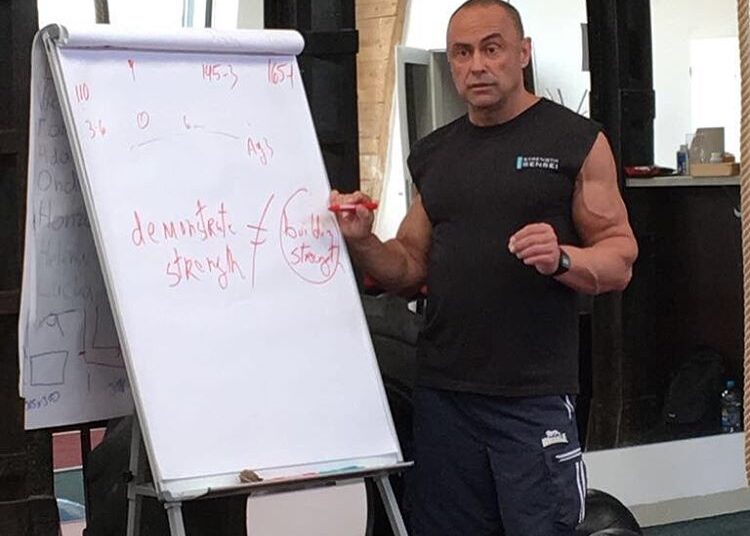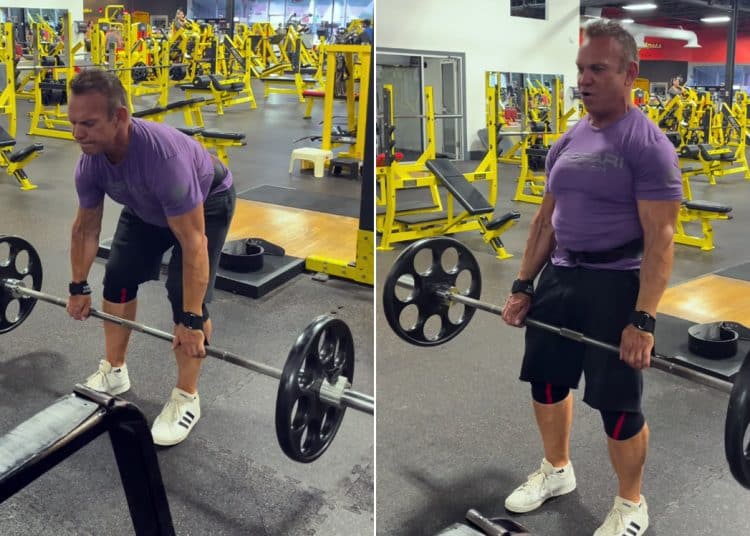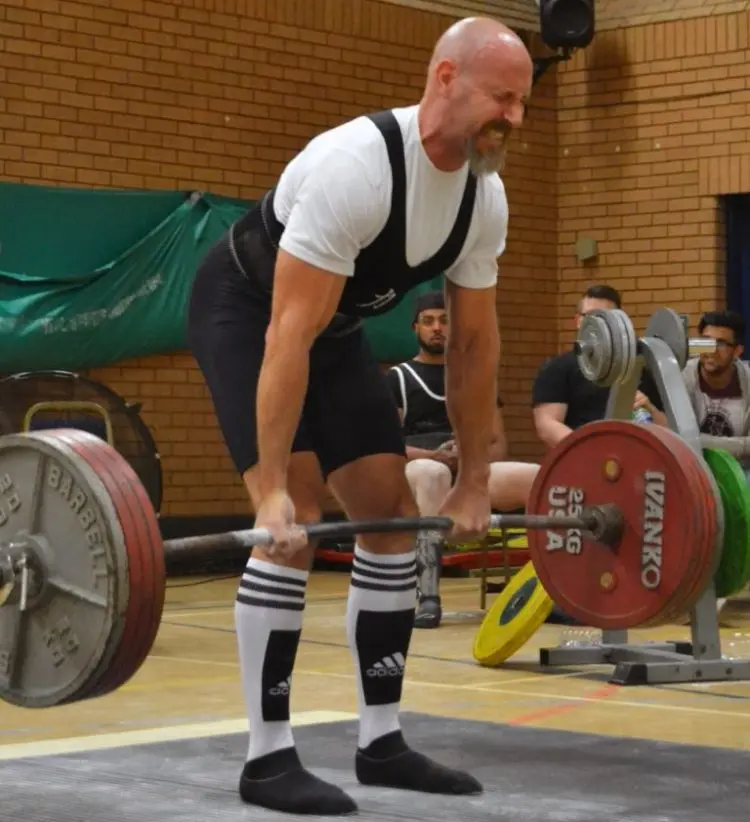Building muscle while losing body fat—known as body recomposition—is considered by many as the holy grail of fitness (1). The alternative, bulking and cutting, is often thought of as old-fashioned and inefficient, which is why methods that promise body recomposition are so highly sought after.
Contrary to what many people think, this shift from bulking and cutting to body recomposition is not recent. In fact, renowned strength coach Charles Poliquin introduced a recomp program back in the early 1990s.
Poliquin worked with athletes from numerous sports, including several Olympians. He also coached and advised many bodybuilders. While often controversial, Charles Poliquin’s training methods were always unique, and he was one of the most well-known training authorities of the late 20th century.
Sadly, Coach Poliquin passed away in 2018 but left behind a wealth of training and nutrition information, including his famous fat-burning, muscle-building system—German Body Composition Training.
In this article, I dust off this classic workout method to determine if it really can deliver on its body recomp promises.
German Body Composition Training Basics

Charles Poliquin’s German Body Composition Training method involves performing upper body/lower body supersets within a full-body workout. This produces a high-intensity, high-volume workout that, Poliquin believed, promotes simultaneous fat burning and muscle building.
Level Up Your Fitness: Join our 💪 strong community in Fitness Volt Newsletter. Get daily inspiration, expert-backed workouts, nutrition tips, the latest in strength sports, and the support you need to reach your goals. Subscribe for free!
According to Poliquin, German Body Composition Training doesn’t just burn a lot of kilocalories during the workout, but it also triggers a powerful afterburn effect, ramping up your metabolism for many hours afterward. Poliquin also believed that this style of training increased growth hormone production, which is a potent muscle builder and fat burner.
Example German Body Composition Program
- Full-Body Session: 3-4 workouts per week
- Tempo: 40X0
- Rest: 30 seconds or less between exercises, 60 seconds between supersets
Superset 1
A1. Leg Press – 3 sets x 10–12 reps
A2. Dumbbell Bench Press– 3 sets x 10–12 reps
Superset 2
B1. Hip Thrust – 3 sets x 12–15 reps
B2. Lat Pull Down – 3 sets x 12–15
Superset 3
C1. High Step-Up – 2 sets x 12–15 steps per leg
C2. Dumbbell Lateral Raises – 2 sets x 15–20 reps
Poliquin recommended following German Body Composition for ten weeks. Adhering to the progressive overload principle, the workouts gradually become more challenging during that time. Coach Poliquin recommended the following structure:
Phase 1: Foundation (Weeks 1–3)
- Focus: Mastering technique, building work capacity, and adapting to high reps and short rest.
- Structure: 10–12 reps per set, 3 sets per superset, 40X0 tempo.
- Rest: 30–60 seconds between exercises to elevate metabolic demand.
- Goal: Lay the groundwork for fat loss and hypertrophy through volume and density.
Phase 2: Intensification (Weeks 4–6)
- Focus: Increase load while maintaining short rest to drive strength gains alongside continued fat loss.
- Structure: 8–10 reps per set, 3–4 sets per superset, same tempo or slightly faster (31X0).
- Rest: Still minimal (30–45 seconds), but weights get heavier.
- Goal: Shift toward more mechanical tension while keeping the heart rate elevated.
Phase 3: Density Boost (Weeks 7–9)
- Focus: Condense more work into less time—higher volume, faster pace.
- Structure: 12–15 reps per set, possibly 4 supersets.
- Tempo: Can vary (e.g., 30X0) to allow higher reps with good form.
- Rest: 20–30 seconds between exercises.
- Goal: Maximize metabolic stress and lactic acid production for continued recomposition effects.
Phase 4: Deload (Week 10)
- Reduce volume and intensity to aid recovery and prep for your next cycle (e.g., hypertrophy, strength, or another recomp block).
Armed with Poliquin’s principles, I created my own German Body Composition Training routine and followed it for four weeks. Here’s the workout I used—and what happened when I committed to it.
My Four-Week German Body Composition Training Plan
I didn’t have time to run an entire 10-week cycle of German Body Composition Training, so I decided to compress Poliquin’s progression methods into four weeks. That meant my workouts followed this structure:
Progression Plan
Week 1 – Phase 1: Foundation
- Reps: 10–12
- Sets: 3
- Tempo: 40X0
- Rest: 30 sec between exercises, 60 sec between supersets
Week 2 – Phase 2: Intensification
- Reps: 8–10
- Sets: 3–4
- Tempo: 31X0
- Rest: 30 sec between exercises, 45–60 sec between supersets
Weeks 3 & 4 – Phase 3: Density Boost
- Reps: 12–15
- Sets: 4
- Tempo: 30X0
- Rest: 20–30 sec between exercises, 45 sec between supersets
Workouts

Because I was only doing this program for one month, I decided to create just three workouts and keep them the same for the entire experiment. This would ensure that I could focus on the progression methods and avoid having to learn new workouts every week.
I trained Monday, Wednesday, and Friday using the following exercises while adhering to the progression plan outlined above:
Workout A
Superset 1
- Front Squat
- Incline Barbell Press
Superset 2
- Romanian Deadlift
- Chin-Ups
Superset 3
- Walking Lunges
- Dumbbell Lateral Raises
Workout B
Superset 1
Level Up Your Fitness: Join our 💪 strong community in Fitness Volt Newsletter. Get daily inspiration, expert-backed workouts, nutrition tips, the latest in strength sports, and the support you need to reach your goals. Subscribe for free!
- Barbell Back Squat
- Dumbbell Incline Bench Press
Superset 2
- Hip Thrust
- One-Arm Dumbbell Row
Superset 3
- Bulgarian Split Squat
- Dumbbell Curl to Press
Workout C
Superset 1
- Trap Bar Deadlift
- Weighted Vest Push-Ups
Superset 2
- Step-Ups
- Lat Pulldown
Superset 3
- Kettlebell Swings
- Plank to Push-Up
Now, let’s dive into how the program actually played out over the course of four weeks, the challenges I faced, and the results I achieved.
Week 1: A Shock to The System
Phase 1: Foundation—Mastering Technique & Building Work Capacity
My training often involves supersets—they’re a great way to save time while increasing workout intensity. However, I usually do push-pull supersets, e.g., biceps curls and triceps pushdowns. While effective, pairing push-pull exercises isn’t too challenging and doesn’t have much of a metabolic impact.
Doing back-to-back upper-body and lower-body exercises was a whole new experience and far more demanding than I had anticipated. My heart and breathing rate went through the roof, and I felt more like I was doing HIIT than strength training.
This, of course, is part of the reason that German Body Composition Training is so effective, so I had no choice but to suck it up and work hard. However, I could already tell that this was going to be a tough month of training, one that I hoped would deliver the results I wanted without burying me!
Week 2–3: Gearing Up for Growth
Phase 2: Intensification—Increasing Load & Maximizing Gains
By Week two, things were starting to heat up. Both volume and intensity jumped in a big way, and I was pushed ever closer to my limits. I had to increase the load while keeping rest periods short, and that made a huge difference to the overall intensity of the workouts.
I was already feeling the strain of the back-to-back supersets, but now I was lifting heavier, and my muscles were being pushed closer to failure than they had been for a while.
The challenge wasn’t just physical; it was mental, too. It required focus and determination to finish every superset and workout. I also had to maintain my discipline and make sure I wasn’t sacrificing form just to move more weight or do more reps.
The shift in tempo and rest periods kept my heart rate high and my metabolism burning like a furnace. The intensity was definitely turned up, and while I was starting to feel fatigued, I could tell this phase was where the real progress would happen.
It was tough, but I was determined to complete the program—I just needed to power through and trust the process.
Week 4: Strong To the End
Phase 3: Density Boost—Maximizing Volume & Metabolic Stress
By the time I hit the final phase, I was really feeling the effects of the previous three weeks of training, both physically and mentally. The goal was to pack even more work into less time, and I knew that wouldn’t be easy. This was the phase I’d been dreading, and I knew it would push me to my limits and maybe even beyond!
With the intensity turned up to the max, I was pushing through supersets with barely any rest, aiming for higher reps and a quicker pace. The volume was through the roof, and my muscles were burning and pumped after every exercise.
Each superset felt like it was tearing me down, but I knew that the combination of volume and intensity was what would drive my progress. The sweat was nonstop, and my heart rate stayed elevated throughout, but this is where the magic of German Body Composition Training really happened.
My Results from Four Weeks of German Body Composition Training

My four weeks of German Body Composition Training were challenging and took my workouts to a new level of intensity. Upper and lower-body supersets produced a cardiovascular and metabolic impact I was not expecting, and even phase one’s foundational workouts tested my fitness and conditioning.
But I powered through and stuck to the program for four weeks, and these are my results:
Decreased Body Fat Percentage
I’m a naturally lean ectomorph and usually maintain around 12-13 percent body fat. However, one month of German Body Composition Training reduced my body fat percentage to 10 percent, and I looked significantly more defined, too.
Given that I made no adjustments to my diet—in fact, I probably ate a little more than usual—this was an impressive result from just 12 workouts, each of which took less than an hour.
It’s also worth noting that I did no additional cardio during this four-week experiment, although I did maintain my habit of walking at least 10,000 steps per day.
Reduced Body Weight
Despite losing body fat, my weight didn’t change by much. In fact, I only lost two pounds. That suggests I gained muscle as I lost fat. While math was never my favorite subject, that means I saw the following changes in body composition:
- Starting Body weight – 180 pounds, 12% body fat
- Finishing body weight – 178 pounds, 10 % body fat
- Body fat lost – 3.8 pounds
- Muscle gained – 1.8 pounds
While these changes might seem small, it’s important to remember that some people go many months without losing fat or building muscle, so I count this as a body recomposition victory.
Improved Fitness and Conditioning
German Body Composition Training is cardio in disguise. My heart rate was always elevated during these workouts, sometimes reaching my anaerobic threshold. As such, I ended the month considerably fitter and better conditioned than at the start. This was reflected in my resting heart rate, which dropped from an already low 55 to 48 BPM.
Increased Drive and Determination
German Body Composition Training is not easy. As soon as you are done warming up, every rep, set, and exercise is performed quickly and with focus. The entire workout is pretty much non-stop, and you have to keep on pushing even as lactic acid floods your muscles.
Of course, you can’t stop for an unplanned rest, as doing so will undermine the effect of the workout. You must dig down deep and push yourself even though your mind is telling you to quit.
Doing this workout after workout will do wonders for your drive and determination. I found conventional workouts much less intimidating as a result, as I knew they could never be as hard as German Body Composition training.
Closing Thoughts
Some fitness experts believe that body recomposition is impossible except for beginners and those using performance-enhancing drugs. However, Charles Poliquin thought it was possible, and after using his training methods for a month, I do, too.
So, if you want to build muscle and lose fat at the same time, give German Body Composition Training a try. While it’s not easy, if you commit and work hard, it will deliver the body recomposition results you’ve always dreamed of.
References:
- McMaster University. (2016, January 27). Losing fat while gaining muscle: Scientists close in on the ‘holy grail’ of diet and exercise. ScienceDaily. Retrieved April 1, 2025, from www.sciencedaily.com/releases/2016/01/160127132741.htm











